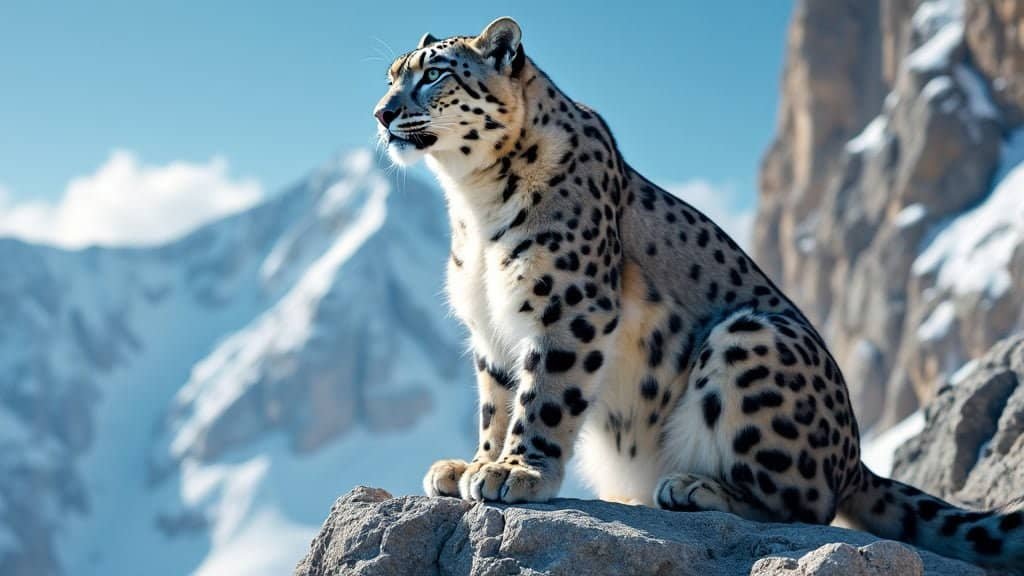Introduction
Snow leopards are well-known for their ability to thrive in some of the highest and most rugged terrains on Earth. One of the key factors contributing to their survival is their heart rate’s remarkable ability to adapt to different altitudes
This article will explore how altitude affects a snow leopard’s heart rate, the physiological mechanisms that enable this adaptation, and the crucial role these adaptations play in their survival
We’ll also examine how these adaptations benefit their hunting strategies, energy conservation, and overall longevity
How Does Altitude Affect A Snow Leopard’s Heart Rate?
Snow leopards, native to the mountainous regions of Central and South Asia, are adapted to thrive in altitudes ranging from 9,800 to 17,000 feet above sea level
These altitudes pose significant challenges due to reduced oxygen levels, which can affect the cardiovascular system. The heart rate of a snow leopard is a critical factor that adapts to these varying conditions, ensuring the animal’s survival in both low and high altitudes
Impact Of High Altitudes On Heart Rate
At high altitudes, the air is thinner, meaning there is less oxygen available for breathing. This reduction in oxygen pressure forces the snow leopard’s body to adapt in several ways. One of the primary responses is an increase in heart rate
By pumping blood more rapidly, the snow leopard ensures that oxygen is efficiently delivered to vital organs and muscles. This adaptation is crucial when the leopard is active, especially during hunting or evading predators. The increased heart rate helps maximize oxygen uptake and maintain energy levels despite the challenging environment
Research on high-altitude mammals has shown that their heart rates can increase significantly at higher altitudes. For example, studies on yaks, another high-altitude mammal, have demonstrated a notable rise in heart rate as they ascend to greater heights
Similarly, snow leopards exhibit an elevated heart rate to counterbalance the reduced oxygen availability. This physiological response is a well-documented survival mechanism in animals adapted to high altitudes
Changes In Heart Rate At Lower Altitudes
When snow leopards descend to lower altitudes, where oxygen levels are higher, their heart rates decrease accordingly. This reduction in heart rate is a way to conserve energy, as the cardiovascular system doesn’t need to work as hard to supply oxygen to the body
In these conditions, the leopard’s heart rate may return to a more “normal” pace, similar to that of other large felines living at lower elevations
The ability to adjust heart rate based on altitude is not only about managing oxygen but also about regulating the overall energy expenditure of the animal
At lower altitudes, the metabolic demands are lower, allowing the snow leopard to reduce its heart rate, conserve energy, and focus on other activities such as feeding, resting, or social interactions
Comparison Of Heart Rate At Different Altitudes
Comparing the heart rates of snow leopards at various altitudes provides insight into their extraordinary adaptability. At high altitudes, the heart rate is significantly elevated, sometimes by as much as 25-30% compared to lower altitudes
This increase is necessary to maintain adequate oxygen supply and prevent hypoxia—a condition where the body or a region of the body is deprived of adequate oxygen supply
In contrast, at lower altitudes, the heart rate decreases to a level that supports normal bodily functions without overexertion. This ability to modulate heart rate ensures that snow leopards can move across different terrains and altitudes without compromising their physiological stability
The variation in heart rate is a testament to the evolutionary adaptations that have equipped snow leopards to survive in one of the harshest environments on Earth
This comparison highlights the remarkable flexibility of the snow leopard’s cardiovascular system, allowing it to function optimally in a wide range of environmental conditions
Understanding these adaptations not only provides insight into the snow leopard’s biology but also underscores the importance of conserving their natural habitats, which are increasingly threatened by human activities
Physiological Mechanisms Behind Heart Rate Adaptation
The snow leopard’s ability to adapt its heart rate to different altitudes is rooted in a complex set of physiological mechanisms
These mechanisms involve the interaction between oxygen availability, blood circulation, and the body’s ability to regulate its internal environment. Understanding these processes sheds light on how these big cats thrive in environments that would be challenging for many other species
Role Of Oxygen Availability In Heart Rate Regulation
Oxygen availability is the primary driver of heart rate adaptation in snow leopards. At high altitudes, where oxygen is scarce, the body needs to compensate to maintain essential functions
The snow leopard’s cardiovascular system is finely tuned to detect and respond to changes in oxygen levels. When oxygen levels drop, sensors in the body, known as chemoreceptors, signal the brain to increase the heart rate
This response ensures that oxygen is delivered more quickly to vital organs, muscles, and tissues, which is crucial during physical activity such as hunting or navigating steep terrains
This physiological response is similar to what is observed in other high-altitude animals and even in humans who live or travel to high elevations. For instance, studies have shown that people who ascend to high altitudes experience an increase in heart rate and ventilation to compensate for lower oxygen levels
The snow leopard has evolved to have an efficient cardiovascular response that allows it to thrive in environments where oxygen levels can drop to 60% of what they are at sea level
Influence Of Altitude On Blood Oxygen Levels
At higher altitudes, the reduced atmospheric pressure leads to a lower partial pressure of oxygen, which means that each breath contains less oxygen. This drop in oxygen availability directly influences the snow leopard’s blood oxygen levels
To counter this, snow leopards have adapted by developing a high red blood cell count, which allows for more efficient oxygen transport throughout the body. Increased red blood cell concentration enhances the oxygen-carrying capacity of the blood, allowing the leopard to sustain a high heart rate without suffering from oxygen deprivation
Moreover, the snow leopard’s hemoglobin—the protein in red blood cells that binds to oxygen—is adapted to have a higher affinity for oxygen. This means that even at lower oxygen levels, their hemoglobin can still effectively capture and transport oxygen to where it is needed most
This adaptation is particularly critical when the snow leopard is active at high altitudes, as it ensures that their muscles receive sufficient oxygen to function properly, preventing fatigue and maintaining endurance
How Snow Leopards’ Hearts Adjust To Altitude Changes
The snow leopard’s heart itself has evolved to manage the challenges of high-altitude living. At the core of this adaptation is the heart’s ability to change its workload based on the altitude
At higher elevations, the heart pumps more vigorously to ensure that oxygenated blood reaches all parts of the body. This increased cardiac output is achieved not only by raising the heart rate but also by increasing the stroke volume—the amount of blood ejected by the heart with each beat
Additionally, the snow leopard’s heart muscle may have structural adaptations that support its function under low-oxygen conditions
Although specific studies on snow leopards are limited, research on other high-altitude mammals, such as Tibetan antelopes, suggests that the heart muscles of these animals are particularly efficient in utilizing oxygen. This efficiency is likely due to a higher density of capillaries, which improves oxygen delivery to the heart muscle itself, ensuring it does not tire easily even at high altitudes
Furthermore, the snow leopard’s ability to regulate its heart rate in response to altitude changes is supported by its autonomic nervous system, which automatically adjusts heart rate based on the body’s needs
This system allows the snow leopard to quickly adapt to sudden changes in altitude, whether it is climbing up steep slopes or descending into valleys
The flexibility of this response is crucial for the snow leopard’s survival, as it enables the animal to maintain its physical activities, such as hunting and territorial patrolling, across a wide range of elevations
Survival Benefits Of Heart Rate Adaptation
The snow leopard’s ability to adapt its heart rate to different altitudes is not just a fascinating physiological trait—it plays a vital role in its survival in the harsh and variable environments of the mountainous regions it inhabits
This adaptation supports essential activities like hunting, energy conservation, and overall longevity, making it a cornerstone of the snow leopard’s survival strategy
Importance Of Heart Rate Adaptation For Hunting
Hunting at high altitudes is particularly challenging due to the thin air and rugged terrain. The snow leopard’s prey, such as blue sheep and ibex, are also well-adapted to these conditions, requiring the leopard to exert significant effort during a hunt
The ability to increase its heart rate at high altitudes is crucial in these scenarios. An elevated heart rate ensures that the snow leopard’s muscles receive enough oxygen during the chase, enabling quick bursts of speed and the endurance needed to pursue agile prey across steep, rocky slopes
In contrast, at lower altitudes where oxygen levels are higher, the snow leopard can afford to have a lower heart rate during hunting. This adaptability allows the snow leopard to conserve energy, making it more efficient in its hunting efforts
By modulating its heart rate based on altitude, the snow leopard can maximize its chances of a successful hunt while minimizing the energy expended, which is critical in an environment where food can be scarce
Impact On Energy Conservation And Metabolism
Energy conservation is a key survival strategy for snow leopards, especially in the cold, resource-scarce environments they inhabit. The ability to adjust heart rate in response to altitude changes directly influences the snow leopard’s metabolism
At higher altitudes, the increased heart rate supports a higher metabolic rate, which is necessary for maintaining body temperature and providing the energy required for intense physical activity
However, this increased metabolic rate also means higher energy expenditure. The snow leopard’s ability to lower its heart rate when descending to lower altitudes or during periods of rest is a critical energy-saving mechanism. By reducing its heart rate, the snow leopard decreases its metabolic rate, allowing it to conserve energy when it is not actively hunting or moving
This balance between energy expenditure and conservation is vital for the snow leopard’s survival, particularly during harsh winters when food is scarce
Moreover, the ability to regulate heart rate helps the snow leopard maintain a stable body temperature in varying conditions. A higher heart rate increases blood flow, which can help generate and distribute heat more effectively in colder environments
Conversely, lowering the heart rate during rest or at lower altitudes helps prevent overheating and conserves vital energy reserves
Relationship Between Heart Rate And Snow Leopard Longevity
The snow leopard’s heart rate adaptation also has implications for its overall health and longevity. By efficiently managing its heart rate across different altitudes, the snow leopard reduces the long-term wear and tear on its cardiovascular system
Prolonged periods of elevated heart rate, such as those experienced by animals constantly living at high altitudes, can lead to cardiovascular strain over time. However, the snow leopard’s ability to lower its heart rate when conditions allow helps mitigate this risk
This adaptability likely contributes to the snow leopard’s relatively long lifespan in the wild, which can be up to 15-18 years
By balancing periods of high cardiovascular activity with periods of rest and lower heart rate, snow leopards can maintain their health and avoid the premature aging or health issues that could arise from constant high-altitude living. This is particularly important given the demanding environment they inhabit, where maintaining peak physical condition is essential for survival
Furthermore, the snow leopard’s ability to modulate its heart rate also helps it cope with the physiological stresses of high-altitude living, such as hypoxia. By efficiently managing oxygen delivery and energy expenditure, the snow leopard minimizes the detrimental effects of these stressors, contributing to its overall health and longevity
Conclusion
The snow leopard’s remarkable ability to adapt its heart rate to different altitudes is a critical survival mechanism that enables it to thrive in the challenging environments of the Himalayas and other mountainous regions
This adaptation allows snow leopards to efficiently manage oxygen intake, energy expenditure, and metabolic demands, whether they are hunting at high elevations or conserving energy at lower altitudes. The physiological mechanisms behind these heart rate changes, such as increased red blood cell counts and oxygen-efficient hemoglobin, are vital for their survival in low-oxygen environments
Moreover, these adaptations not only enhance their hunting success but also contribute to their overall health and longevity by balancing cardiovascular strain. Understanding these adaptations underscores the importance of conserving the natural habitats of these elusive big cats, as their survival is intricately linked to the unique conditions of their high-altitude environments













